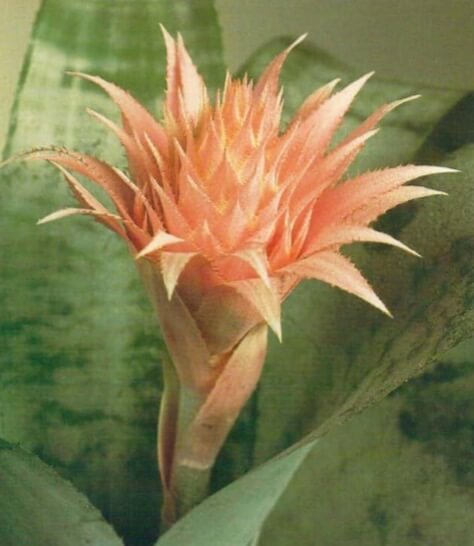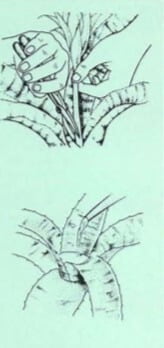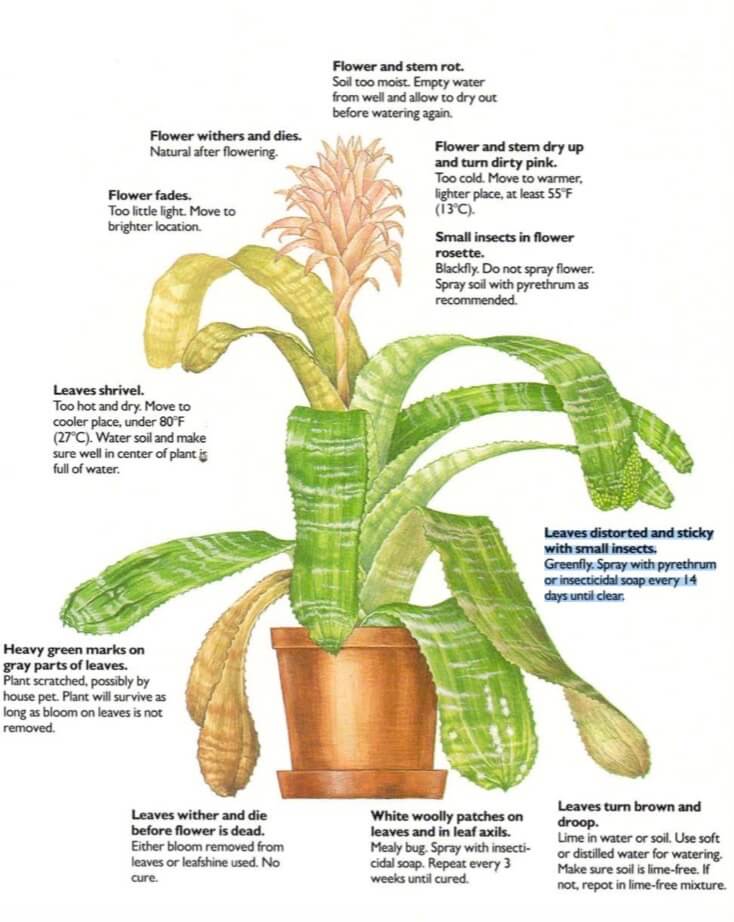[Ebook Việt Hoá] The Instant Guide to Healthy Houseplants (Hướng dẫn tức thời để chăm cây trong nhà khoẻ mạnh), Chi Aechmea
[Ebook Việt Hoá] The Instant Guide to Healthy Houseplants: Aechmea fasciata (Urn plant)
- Nguồn: [Ebook Việt Hoá] The Instant Guide to Healthy Houseplants (Hướng dẫn tức thời để chăm cây trong nhà khoẻ mạnh)
- Biên tập: Dũng Cá Xinh
- Biên dịch: Team Codai.net
English
This splendid bromeliad grows naturally in trees, with just enough roots to hold itself in place. Its outstretched leaves gather rain into a central well (through which it absorbs the food it needs) and the small quantities of methane gas that trigger flower formation. When buying an urn plant, look to see that the flower bud has just formed. If not, the trigger for flowering may be provided by covering the plant after 18 months with a polyethylene bag for 4 weeks and enclosing a rotten apple core. After flowering, the parent plant begins to die; but new offsets, which can be repotted, form at its base. Several cultivars are available, including ‘Variegata’, ‘Albomarginata’, ‘Purpurea’ and ‘Superba’.

Light
Tolerates strong sunlight and survives in shade. Needs good light for flowering.
Temperature
Minimum, 55°F (13°C); maximum, 80°F (27°C).
Water
Fill center well with soft or dis- tilled water; allow excess to trickle into soil, which should be just moist. Empty well and change water every 3 weeks.
Humidity
No extra spraying is necessary at normal room temperatures. Do not keep in a cold, damp place.
Soil
Use peat-based soil, with I part leaf mold to 3 parts loam or potting soil. It must be lime-free.
Feeding
Though unnecessary, a diluted dose of liquid houseplant food added to the water in the well every month in summer will help keep plant healthy. Use only a quarter as much food as the manufacturer recommends.
Repotting
When plant dies, becoming dull and shrivelled, tease away off-set shoots from base, carefully retaining some root. Pot individually into 5-in (13-cm) pots. They will not need repotting again.
Cleaning
Wipe carefully with feather duster if dusty or dirty. Do not disturb gray bloom. Use no leafshine.
Removing the flower stem
When flower spike has died, cut its stem at base with pruning shears.
Watering
Keep about 1 inch (2 1/2 cm) water in the plant’s central well. Rainwater is best. Every 3 weeks, empty old water and add fresh.

What Goes Wrong

- Flower withers and dies: Natural after flowering.
- Flower fades: Too little light. Move to brighter location.
- Leaves shrivel: Too hot and dry. Move to cooler place, under 80°F (27C°). Water soil and make sure well in center of plant is full of water.
- Flower and stem rot: Soil too moist. Empty water from well and allow to dry out before watering again.
- Flower and stem dry up and tum dirty pink: Too cold. Move to warmer, lighter place, at least 55°F (13°q.
- Small insects in flower rosette: Blackfly. Do not spray flower. Spray soil with pyrethrum as recommended.
- Heavy green marks on gray parts of leaves: Plant scratched, possibly by house pet. Plant will survive as long as bloom on leaves is not removed.
- Leaves wither and die before flower is dead: Either bloom removed from leaves or leafshine used. No cure.
- White woolly patches on leaves and in leaf axils: Mealy bug. Spray with insecticidal soap. Repeat every 3 weeks until cured. .
- Leaves turn brown and droop: Lime in water or soil. Use soft or distilled water for watering. Make sure soil is lime-free. If not, repot in lime-free mixture.
- Leaves distorted and sticky with small insects: Greenfly. Spray with pyrethrum or insecticidal soap every 14 days until clear.
Tiếng Việt
Cây dứa cảnh lộng lẫy này mọc tự nhiên trên cây và chỉ có rễ để giữ cố định. Những chiếc lá vươn ra của nó gom mưa vào giếng nước ở giữa (qua đó nó hấp thụ dinh dưỡng cần thiết) và một lượng nhỏ khí mêtan kích hoạt sự hình thành hoa. Khi mua cây dứa cảnh, hãy quan sát nụ hoa nở. Nếu không, có thể kích thích ra hoa bằng cách bọc cây sau 18 tháng bằng túi polyetylen trong 4 tuần. Sau khi ra hoa, cây mẹ bắt đầu chết; nhưng mầm cây mới sẽ hình thành ở gốc. Một số giống cây trồng có sẵn, bao gồm ‘Variegata’, ‘Albomarginata’, ‘Purpurea’ và ‘Superba’.

Ánh sáng
Chịu được ánh nắng mạnh và sống được trong bóng râm. Cần ánh sáng tốt để ra hoa.
Nhiệt độ
Tối thiểu, 55 ° F (13 ° C); tối đa, 80 ° F (27 ° C).
Nước
Đổ nước mềm hoặc nước cất vào giữa; để nước thừa thấm vào bên trong đất trồng nhằm giữ độ ẩm. Thay nước 3 tuần một lần.
Độ ẩm
Không cần phun thêm ở nhiệt độ phòng bình thường. Không để nơi lạnh, ẩm ướt.
Đất
Sử dụng đất làm từ than bùn với nấm mốc 1 phần nấm mốc đến 3 phần đất mùn hoặc đất bầu. Chúng phải không có vôi.
Bón phân
Mặc dù không cần thiết, nhưng mùa hè thêm một lượng phân bón dạng lỏng được pha loãng với nước vào giếng hàng tháng vào mùa hè sẽ giúp cây khỏe mạnh. Chỉ sử dụng một phần tư lượng phân bón theo khuyến cáo của nhà sản xuất.
Thay chậu
Khi cây chết sẽ trở nên xỉn màu và teo tóp, hãy cắt bỏ những chồi non ở gốc, cẩn thận giữ lại một số rễ. Đặt riêng vào các chậu 5 inch (13 cm). Chúng sẽ không cần thay chậu một lần nữa.
Làm sạch
Lau cẩn thận bằng khăn lau lông nếu bị bụi hoặc bẩn. Đừng làm đụng vào hoa đang nở. Không sử dụng xịt bóng lá.
Loại bỏ cuống hoa
Khi cành hoa đã tàn, hãy dùng kéo cắt tỉa cành ở gốc.
Tưới nước
Giữ khoảng 1 inch (2 1/2 cm) nước trong giếng giữa của cây. Nước mưa là tốt nhất. Cứ sau 3 tuần, đổ hết nước cũ và bổ sung nước mới.

Các vấn đề có thể xảy ra

- Hoa héo và tàn: Tự nhiên sau khi ra hoa.
- Hoa tàn: Quá ít ánh sáng. Di chuyển đến vị trí sáng hơn.
- Lá co rút: Quá nóng và khô. Di chuyển đến nơi mát hơn, dưới 80 ° F (27C °). Tưới nước vào đất và đảm bảo đầy đủ nước ở giữa cây.
- Thối hoa và thân: Đất quá ẩm. Đổ hết nước trong giếng và để khô trước khi tưới lại.
- Hoa và thân khô héo: Quá lạnh. Di chuyển đến nơi ấm hơn và sáng hơn, ít nhất là 55 độ F (13 độ C).
- Côn trùng nhỏ trong hoa thị: Ruồi đen. Không phun hoa. Phun đất với pyrethrum theo khuyến cáo.
- Vết xanh đậm trên các phần của lá: Cây bị trầy xước, có thể do vật nuôi trong nhà. Cây sẽ tồn tại miễn là không bị cắt bỏ hoa nở trên lá.
- Lá héo và chết trước khi hoa tàn: Loại bỏ hoa nở khỏi lá hoặc sử dụng xịt bóng lá. Không có thuốc chữa.
- Các mảng lông tơ màu trắng trên lá và ở nách lá: Rệp sáp. Xịt bằng xà phòng diệt côn trùng. Lặp lại 3 tuần một lần cho đến khi khỏi bệnh. .
- Lá chuyển sang màu nâu và rũ xuống: Vôi trong nước hoặc đất. Sử dụng nước mềm hoặc nước cất để tưới. Đảm bảo đất không có vôi. Nếu không, hãy tìm hiểu cách trộn trên mạng.
- Lá méo mó và dính côn trùng nhỏ: Ruồi xanh. Xịt bằng pyrethrum hoặc xà phòng diệt côn trùng 14 ngày một lần cho đến khi khỏi bệnh.
![[Ebook Việt Hoá] The Instant Guide to Healthy Houseplants: Aechmea fasciata (Urn plant) [Ebook Việt Hoá] The Instant Guide to Healthy Houseplants: Aechmea fasciata (Urn plant)](https://vn1.vdrive.vn/codai.net/2020/02/ebook-huong-dan-tuc-thoi-cham-cay-trong-nha-khoe-manh-26-aechmed-fasciata.jpg)


